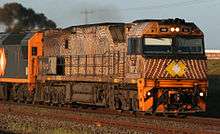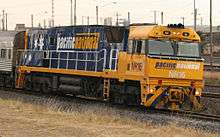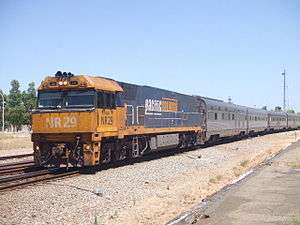NR class
|
NR29 in Pacific National livery hauling the Indian Pacific in January 2008 | |||||||||||||||||||
| |||||||||||||||||||
| |||||||||||||||||||
| |||||||||||||||||||
| |||||||||||||||||||
The NR class are a class of diesel locomotive built by A Goninan & Co for National Rail between 1996 and 1998. They are currently operated by Pacific National. The QR National 5000 (and 5020) class locomotives, and all the C44aci model locomotives build by UGL Rail at Broadmeadow adopted the design from the NR Class, but with a variety of features to set them apart from each other and the NR Class locomotives.
History





Upon commencing operations in April 1993 the National Rail inherited a diverse collection of rolling stock to operate interstate freight operations in Australia.[1] The fleet included locomotives of mixed age and power leased from FreightCorp, V/Line and Australian National.
In September 1995 A Goninan & Co were awarded a contract for 120 locomotives from National Rail which were built at their Broadmeadow (NR1-NR60) and Bassendean (NR61-NR120) factories.[2][3] The frames were built at Hexham and the bogies at Goninan's Landsdowne Engineering subsidiary in Taree.[2][3]
The first locomotive to be completed was NR61 which performed its first trial on 18 September 1996 between Midland and Jumpakine.[4] The first Broadmeadow built unit first ran on 23 September 1996.[4] The first units were delivered without National Rail branding or logos, but later units were delivered in full livery. Testing of the units was carried out on the NSW Main Northern line between Werris Creek and Maitland using ballast wagons and 442 class locomotives in dynamic braking mode as dynamic loads.[5] Each locomotive was required to accumulate 10,000 km of trouble free running before acceptance.[2] In February 1998 Broadmeadow delivered the last NR class.
As part of its contract, A Goninan & Co was required to maintain the fleet. A depot was built alongside the Newport to Sunshine railway in the western Melbourne suburb of Spotswood for this.[2][3]
Into service
With the arrival of the class, National Rail was able to return leased units to their owners, including 422, 80, 81, and 82 class locomotives to FreightCorp, and 442s and 48s class locomotives to Silverton Rail.
The V/Line C class (which were owned by National Rail) and relatively new EL class were withdrawn.[2][6] Once all 120 units were delivered, National Rail retained the AN, BL and DL class locomotives, along with thirteen 81 class and several hired G class. The new locomotives were placed on time sensitive trains first.[2]
When first delivered, the NR class were banned from running in New South Wales by the Environment Protection Authority due to excessive noise when under dynamic braking but the ban was lifted after further testing. The class could also not lead on the Victorian standard gauge network due to the lack of suitable radio equipment. In later years NR76 to NR98 were provided with V/Line Section Authority System equipment to work the Western standard gauge line, while NR1 to NR13 and NR61 to NR72 were fitted with V/Line radios to operate on the Victorian North East line.[2]
Great Southern Rail contracted National Rail to haul its services, the first train running with NR77 on 1 November 1997. All were included in the sale of National Rail to Pacific National in February 2002.
Accidents
NR3 was involved in an accident at Robertson that killed two crew members, it was rebuilt as NR121. In June 2006 NR33 was involved in level crossing incident, being the third locomotive on a Melbourne to Adelaide freight service, behind DL40 and NR52. It was subsequently written off and scrapped.[7] On the 3rd of April 2016 NR8 was involved in a fire at Cardiff NSW. The locomotive is currently in storage awaiting rebuild. On the 21st of April 2016 3MP5 a Melbourne to Perth intermodal freighter derailed near Rawlina in Western Australia. The two locomotives NR34 and NR50 were badly damaged and have been written off as well as a large number of rollingstock.
NR33=scrapped NR34=scrapped NR50=scrapped NR8=stored and awaiting rebuild NR121 (formerly NR3) rebuilt and in service
Features
The NR Class introduced many new features. These were the first locomotives in Australia to have "variable horsepower", which meant that the power output of the engine had three different settings, making the NR class the most fuel-efficient locomotives in Australia. They have GE 7FDL-16 engines, with power levels of 2,850 hp (2,130 kW), 3,560 hp (2,650 kW) or 4,020 hp (3,000 kW), mass of 132 t (130 long tons; 146 short tons), a Co-Co wheel arrangement and a maximum speed of 115 km/h (71 mph). In fact the "variable horsepower" feature (so-called) was little more than a talking point (selling point?) and something of a furphy as far as being a valid feature went. Rather than going through the complicated process on the cab DID panel to configure the locomotive for a particular "variable power" configuration, precisely the same outcomes could be achieved simply by the driver voluntarily limiting operation to throttle positions 7 (to produce 3,560 hp or 2,650 kW operation) or 6 (for 2,850 hp or 2,130 kW operation).
The NR Class cab was designed taking into consideration the results of an extended consultative process with the end users. This has resulted in a cab that has been well accepted. The layout of the control stand evolved from a British Rail Class 60 cab, and is substantially different from the more common AAR type I (stand) and Type II (desk) cabs.[8]
The design is a long hood unit locomotive, with only one cab but two separate sets of controls, which allow it be driven either "A" or "B" end leading. This locomotive had to pass all tests, such as being able to shunt if required, drive "long end leading" if needed, and allow drivers to do checks on fuel, brakes, and sand. Despite the twin controls, operation of the class "B" end leading is avoided, with single NR classes being turned on turntables to ensure they face the correct way.[2]
In 2013 UGL Rail, Spotswood fitted NR17 with ECP/WDP braking systems for use on quarry traffic in New South Wales. It has been reclassified as NRE17.[9]
Liveries
The class were delivered painted in the orange and grey National Rail livery, with a few exceptions that were delivered in special customer liveries or that of National Rail business units:[10][11]
- NR30 & NR52 depicting Aboriginal artworks
- NR53 - NR55 in green Trailerail livery
- NR56 & NR57 in blue & white Seatrain livery
- NR58 - NR60 in grey & white Steelink livery
Many locomotives have been named, the first being done on delivery.[2] They were done at operational convenience rather than in groups of numbers. Names include cities and suburbs served by National Rail, in addition to their depots and maintenance centres. The special livered locomotives were given related names. It had been intended to name all locomotives, but by February 2000 only 70 had been named, a number not much larger today.[2][12][13]
With Pacific National ownership further changes were made, the Pacific National decals placed over the side air deflectors replacing the National Rail signage. From 2006 the National Rail diamonds on the side and ends of the locomotives were removed or painted over. Most have now been repainted into Pacific National livery.[13]
Some have been repainted into special liveries:[13]
- NR74, NR75 & NR109 in red The Ghan livery
- NR25,26,27,28 in blue & yellow Indian Pacific livery
- NR84 & NR85 in 2008 in the ill fated green & white The Southern Spirit livery
- NR18 in 2011 in a shaded yellow grey and orange Indian Pacific"livery
References
- ↑ "Background - Organisation of Australia's Railways". www.infrastructure.gov.au. Retrieved 2008-11-10.
- 1 2 3 4 5 6 7 8 9 10 Antony Fitzgerald (April 2000). "The Dash 9 in Australia: National Rail's NR class". Australian Model Railway Magazine. pp. 27–30.
- 1 2 3 "National Rail Loco Contract Signed" Railway Digest October 1995 page 6
- 1 2 "First Perth-Built NR Class Commence Trials Ahead of NSW Units" Railway Digest October 1996 page 6
- ↑ "NR Class Testing" Railway Digest November 1996 page 4
- ↑ "The NR class locomotives & National Rail's motive power fleet" Railway Digest April 1998 page 16
- ↑ "NR33 Under the Torch". Railpage Australia Forums (Locomotives and Rolling Stock). www.railpage.com.au. Retrieved 2008-11-10.
- ↑ Hussey, F. (2005). How the NR Class got their cabs: in The NR Class - a Loco for Australia. Railway Digest, 43(9), 29.
- ↑ NRE class Railpage
- ↑ Railway Digest November 1997 page 43
- ↑ "Indigenous Design Loco Colours Unveiled" Railway Digest December 1997 page 8
- ↑ NR Class Railpage
- 1 2 3 NR Class Vicsig
Bibliography
External links
- Railpage Australia - NR Class Comprehensive Database
 Media related to NR class at Wikimedia Commons
Media related to NR class at Wikimedia Commons
